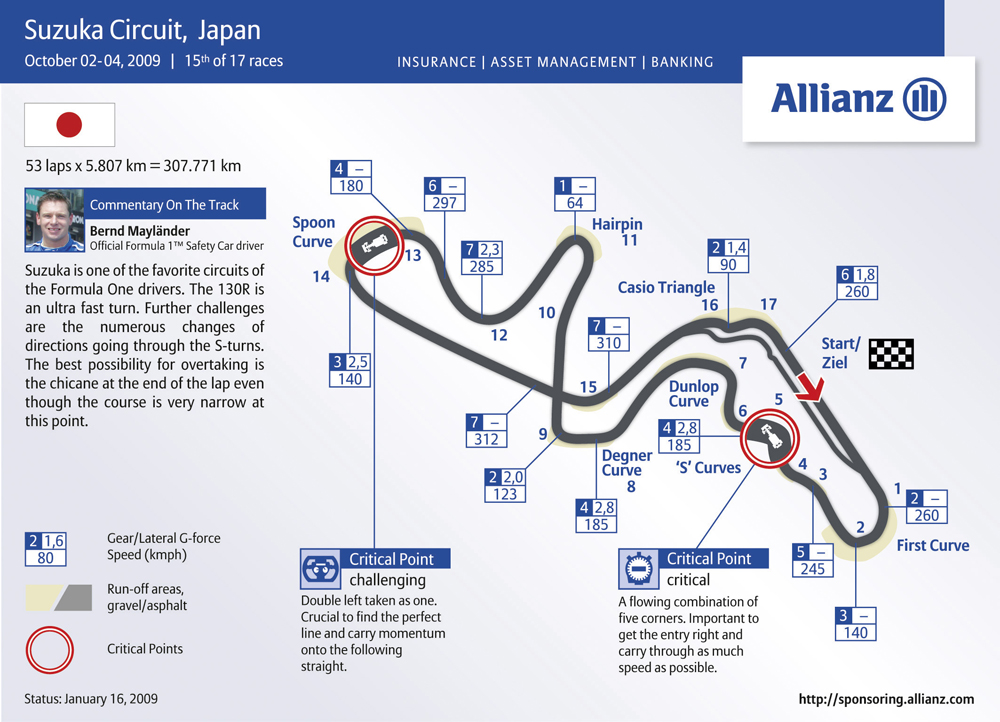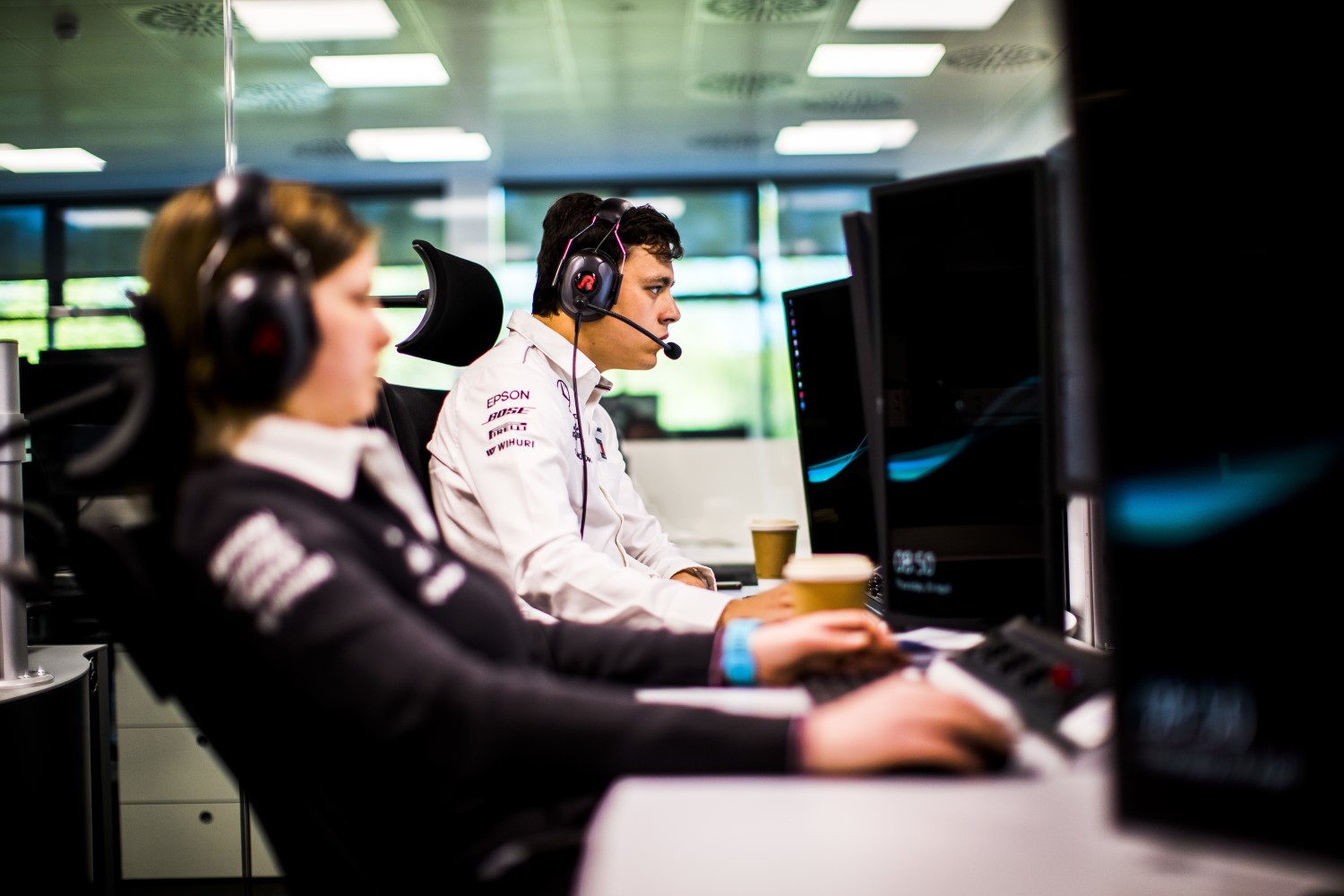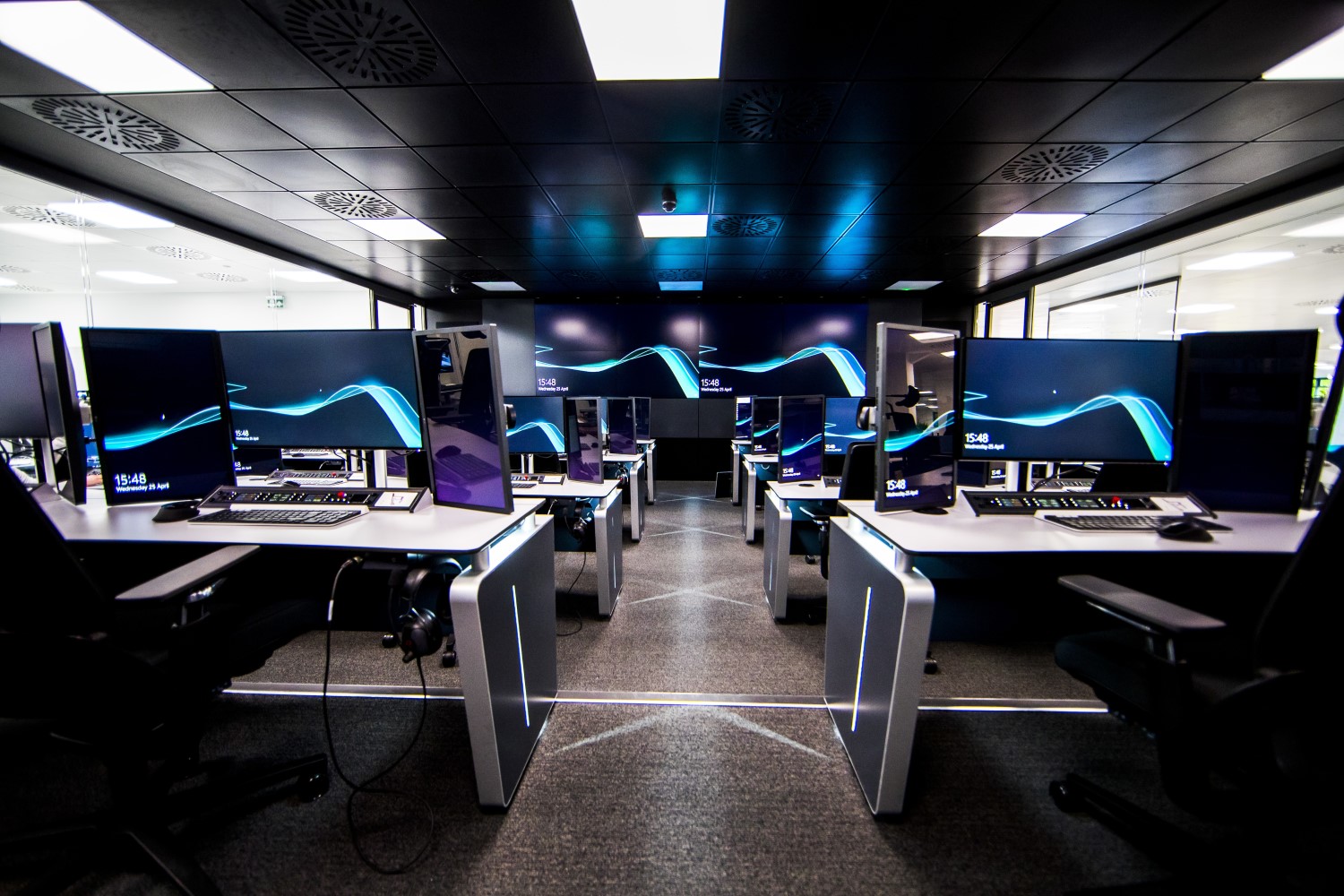Japanese GP Preview
 |
|
Circuit Length: 5.807 kilometers (3.608 miles) Laps: 53 Race Distance: 307.471 kilometers (191.054 miles) Broadcast: ESPN2 (12:30 a.m. EDT on Sunday, Oct. 7) |
The Japanese Grand Prix marks the fifth to last event in the 2018 FIA Formula One World Championship, and fifth-place Haas F1 Team is eyeing Sunday’s race at the 5.807-kilometer (3.608-mile), 18-turn Suzuka Circuit as a strong opportunity to take fourth place in the constructors’ standings before heading home for the United States Grand Prix at Circuit of the Americas in Austin, Texas.
The layout of Suzuka is a figure-eight, and it is the only track in Formula One with such a configuration. A bridge overtop the straight that links turns nine (Degner 2) and 10 is a signature of the track, with drivers nearing 330 kph (205 mph) as they go across the bridge through turn 15, better known as 130R, so named because of its 130-meter radius.
The first sector of the track caters to a car’s aerodynamic efficiency, while the second sector rewards horsepower. The entire course features every kind of corner, and its relatively old asphalt surface provides a high level of grip, which combined with high lateral loads through the corners accelerates tire wear. As such, Pirelli has brought its White medium, Yellow soft and Red supersoft compounds to Japan as the island nation becomes acceleration nation.
While the end of the Formula One season is in sight, the sun is a long ways from setting.
Q&A with Guenther Steiner
You confirmed your driver lineup before the Russian Grand Prix, with Grosjean and Magnussen returning for another season. How helpful is it to have your driver lineup set and not a distraction as you battle for fourth in the constructors’ standings?
“It’s the best it can be. You know what you’re doing, everybody knows what we’re doing, and we can focus on trying to get fourth place in the constructors’ standings. There are no negatives, only positives."
Haas F1 Team has made great strides from last year to this year. How much of that is attributable to having a consistent driver lineup, and do you expect it to deliver continued dividends in 2019?
“It’s difficult to say how much it influences, but for sure it is helpful. Consistency for a team is very good, provided you have the right consistency in the quality of the people. Anything new you do, people need to adapt, and there is a learning period which normally means it’s not taking you forward. At best, it keeps you where you are. It takes time to gel and to work together in any position in the team, especially with the drivers."
You go from one of the smoothest tracks in Formula One – the Sochi Autodrom – to one of the roughest tracks in Suzuka Circuit. How does the weathered asphalt of Suzuka change your preparation in comparison to what you did for Sochi?
“Nothing changes. We take the data from Suzuka and use it for our preparations. We have all the data from the racetracks. We just adapt our simulations to whatever tires are used and whatever the track surface is."
After two straight races where the softest tire in Pirelli’s lineup was used – the Pink hypersoft – we’re back to a more traditional White medium, Yellow soft and Red supersoft tire combination. After struggling to sort how much longevity you could get from a set of hypersofts, is it advantageous to get back to a tire lineup you know well where each tire compound is only a step away from one another in terms of grip level?
“With tires, it’s not as easy as this. The track surface is in play, and where the tire works is a second component. It’s not saying they are now close together again and it’s better, it’s different from track to track. You cannot compare one with the other."
Is tire management more of a factor at Suzuka than it was at Sochi because the surface is more abrasive? If so, how do you manage your tires at Suzuka?
“We don’t know that yet. It depends on how the tires work on Friday. When we test in FP1 and FP2, then we know what we have to do. At this moment in time, it’s very difficult to predict."
High-speed stability in regard to mechanical stiffness and aerodynamic balance seem to be the key to success at Suzuka. What do you do to achieve that?
“You can’t do a lot more than what your car has already, and we are pretty confident that what we’ve got is working well. We just need to find a balance for the weekend. Japan is high speed and there are some challenging corners, but it’s a nice place to be and I hope we can find a good setup and show what we can do."
There seems to be a delicate balance at Suzuka in regard to downforce. Too much and you go slowly down the straights. Too little and the driver won’t have the confidence to attack the track’s twists and turns. Obviously, the level of downforce is predicated on how comfortable the driver is at speed. How do you find this balance between the needs of the car and the needs of the driver?
“It’s one of those things that go hand-in-hand. Once you find the quickest way around the track by balancing top-end speed versus downforce, the driver is quite happy because he wants to be quickest around the track. For them, the happiest is when they get a good lap time."
Understeer through the esses between turns three and seven is often at the top of the to-do list at Suzuka. How do you address understeer and at what point does a change to help the car in one section of the track hurt it in another section?
“It’s mainly about how your car is set up from the beginning. You can always get a little understeer, but then you introduce oversteer into the other parts of the track. We will see how we end up."
With all the investment that goes on in Formula One, is the investment a team has made in its driver lineup perhaps best on display at Suzuka?
“Absolutely. You need to be a brave man around Suzuka. You’re at high speed and when you go off, sometimes it’s not a soft landing. You need to be brave, but you also need to be very technical to set the car up. Suzuka is definitely a track that tests driver skill."
Beyond the racetrack, what is most often talked about at Suzuka is the passion its fans have. Can you describe the atmosphere at the track and the fervency Japanese fans have for Formula One?
“I think it’s very special. If you are a fan at Suzuka, you are a diehard fan. They will be lining up outside. It’s quite amazing how much they love it. I think a lot of people look forward to it because it’s so different from anywhere else."
Japan has some fantastic and unique cuisine. What is your favorite?
“Any sushi or sashimi. I look forward to it."
When you leave Japan you’ll be gearing up for your home race – the United States Grand Prix in Austin, Texas. Where do you want Haas F1 Team to be at that time and what will your thoughts be on that long flight back to North Carolina?
“Hopefully on the flight back, I can think about a lot of points. That always puts your spirits high – when you fly home and you bring something back. We’ve never had a strong United States Grand Prix. I know everyone wants this to happen – to have the American team having a strong home race. Everybody’s working hard for that. Hopefully, this year we can pull it off."
Toto Talks Japan
The true strength of a team reveals itself in what individuals are prepared to sacrifice for the group. Valtteri was willing to sacrifice his win in Sochi to help protect our 1-2 and extend our lead in both championships – and he said he'd be prepared to do the same again tomorrow. That tells you everything you need to know about the quality and integrity of his character. Valtteri proved in Sochi that he is a race-winning Grand Prix driver: he put it on pole, controlled the race and had the pace to win. And he also showed that he is a great team player when we need him to be in the final stages of the season.
It wasn't an easy call to make even though it was the right one for the points situation. I think every one of us was facing this struggle between our head and our heart on Sunday, but there is no hard-and-fast rule or matrix you can apply. Whatever scenarios you think through, the old military saying is that "no plan survives first contact with the enemy", and we saw that again in Russia with how the race unfolded. Each call has its own context and we may face more tough moments before the year is over. But we will handle each one on its merits and face them together, as a strong team.
[adinserter name="GOOGLE AD"]In the end we left Sochi with a bigger lead in both championships. But we know that doesn't mean anything because our fight with Ferrari is far from being over. We can take nothing for granted and we will stay at maximum attack on every front in the next races. The battle with Ferrari remains extremely close, as was underlined by Sebastian's pace on Sunday and the pressure he put us under. Lewis was in Brackley this week and is hungry, focused and completely determined to succeed: it has been great to see the power he has brought to this championship, and how he has taken it to the next level since the summer break.
Suzuka will be another challenging weekend for us – we will need the very best from our team, our car and our drivers to come out on top. It's a track that shows some similarities to Silverstone, where we didn't perform as strongly this year as we had done in previous seasons. So we're going to Japan knowing that we all have to be at our very best if we want to claim the win.
Featured this week: Supporting the Race from Afar
 |
| Remote race support personnel |
It has been called many things – "operations center", "virtual garage" or "mission control" for example. Most of those designations, however, are actually a misnomer and somewhat misleading, as they don't really caption the essence of the room. Which is why we call it "Race Support Room" -but how does it work?
Up to 60 team personnel will work on the cars in Suzuka – the maximum number of technical staff the FIA Sporting Regulations allow to be "associated in any way with the operation of the cars within the confines of the circuit". Outside those confines, however, more people can support the race team in ways that don't require physical access to the car. For Mercedes-AMG Petronas Motorsport, these people sit in the Race Support Room or more commonly referred to as the "RSR".
How many people work in the RSR?
The Race Support Room has a maximum capacity of 30 people. The majority of those are volunteers – industrial placement students who choose to give up their spare time to support the race team. In addition to those volunteers, there are also engineers from various departments – tire, systems and race engineers as well as aerodynamicists and strategists. Finally, the RSR is also a training facility for young team members aiming to join the race team
What do the people in the RSR do?
One of the most important jobs of the industrial placement students is listening to the radio messages from the other teams. This form of eavesdropping was made possible in 2016, when the teams opted to bring back the chance to give engineering support to the drivers over the radio – a form of communication that had been banned for the 2016 season and left the drivers without any support when they encountered a technical issue. The people in the RSR also look at the various video feeds to see the race from as many angles as possible. If, for example, there's contact with one of our cars, they will find the right video snippet as quickly as possible and send it over to the aerodynamicists, so the footage can be analyzed and checked for possible bodywork damages.
Are there any tasks that are only done in the RSR?
Yes, quite a lot. All video clipping and audio transcription is done in the RSR. In addition to that, the vast majority of the overload monitoring is also exclusively done back at base in Brackley. RSR personnel are also responsible for measuring pit-lane times which are important for strategy calls. The strategists in the RSR support the strategists at the track and provide input and background information to help make the right calls. However, the final strategy decision is always taken on the pit wall at the track.
How are people trained in the RSR?
If you're training to become a trackside engineer, the RSR will usually be the first part of your training. You'd spend at least a year working in the RSR and getting track experience during testing before you're sent out to the track for a race.
Beyond this "on-the-job" training though, the RSR also helps develop young graduates and placement students by using a learning session called "Racing 101". It's a meeting held on Sunday morning before the race and it is used to answer every possible question one might have. There's just one fundamental rule: there are no stupid questions!
Is being away from the track a big disadvantage for the RSR personnel?
 |
| Support Room |
No, it's actually an advantage. The fact that the people in the RSR have no way of physically working on the car gives them a clear focus. They can look at the bigger picture and analyze how we are doing relative to the competition. They also look at various systems on the car and see if they're working the way they're intended to. If something is not working as planned, help is not far away – especially on Friday, when the factory is fully staffed: the RSR is right next to the Design Office, where they can always talk to the person who designed the part. There are also systems engineers in the RSR who look after the reliability of the car and will monitor the data from specific systems. They check, for example, suspension loads when the car is going over a curb to make sure the loads were not too high and the suspension was not damaged. If a systems engineer finds evidence in the data that clearly indicates that a system is about to fail and the car becomes dangerous to operate, he will inform the chief engineer who is responsible for the safety and reliability of the car and has the authority to make the call to box the car if needs be.
Does the RSR have access to the same data as everyone at the track?
Yes. The RSR crew gets access to the full telemetry data within one second of it being available trackside. At the same time, the engineers at the track also have access to all the data that is created in the RSR. Over the course of a race weekend, about 120 Gigabytes are sent from the track to the RSR and about the same volume of data in the other direction. The RSR also has access to the same radio messages as the personnel at the track and receive them with only minimal delay. The latency for a European race is about 0.3 of a second. For the race in Australia, the delay is about 0.7 seconds and for the upcoming race in Japan it will be about 0.5 seconds.
How is the RSR set up?
The team uses a dedicated room, which is built as a theater with everyone facing the same direction, giving them all the chance to work on their individual tasks on the three screens in front of them and seeing more general information on the big screens that make up one wall of the facility. The main screens will display the on-board and pit lane feeds, a timing page and race analysis software. Each seat in the RSR is fitted with an intercom panel, giving everyone access to the radio channels he or she requires for the role. While this form of communication is key to reaching the right decisions, it is also quite tricky to get used to at first. When the team invites guests into the RSR, they have the tendency to take their headsets off initially because they're overwhelmed by the radio traffic on the roughly 30 channels the team uses.
Is there an RSR in Brixworth as well?
Yes, there's a very similar room at Mercedes-AMG High Performance Powertrains (HPP) in Brixworth, although that one is referred to as the TSO – which is short for "Track Support Office". The people at the TSO not only look after the Power Units in the Mercedes-AMG F1 W09 EQ Power+, but also the other Mercedes engines in the Force Indias and Williams.
